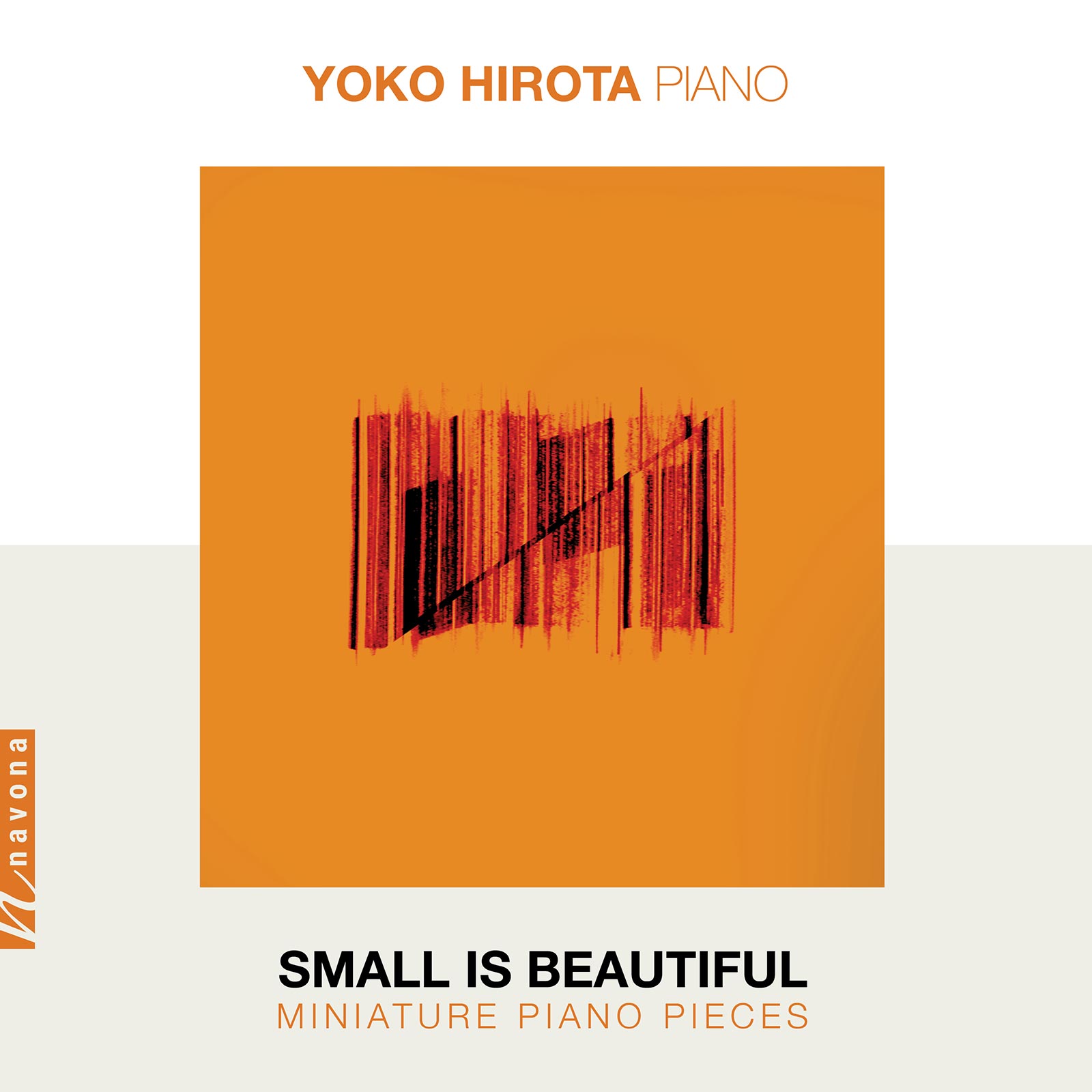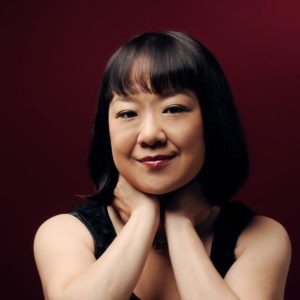
Share Album:
Small is Beautiful
Yoko Hirota piano
Japanese-Canadian pianist Yoko Hirota stuns with impeccable pianism on SMALL IS BEAUTIFUL: MINIATURE PIANO PIECES. Originally recorded in 2009, this remastered edition brings out the intricacies of 20th- and 21st-century piano composition with a clarity that was previously unheard of.
The first half of the album's track list reads like an exhaustive compendium of 1900's compositional celebrities: Schoenberg, Krenek, Ligeti, Berio. It's a brainy choice: the tracks on SMALL IS BEAUTIFUL aren't ordered by length, as one might intuit, but instead in geographical and roughly chronological order. Vienna's modernists may have laid the foundation, but North America's modernists took serial and atonal composition to the next level. And so, to do the matter justice, there is a splendidly representative selection of Elliott Carter’s oeuvre, along with pieces by Canadian composers - John Beckwith. Despite the immense differences in cultural background and era – the selection spans almost a century, after all – they are all united by one distinguishing feature: They are short pieces, with lengths between 31 seconds and six-and-a-half minutes.
Yoko Hirota, who holds a doctoral degree in piano performance and currently teaches the piano at the Music Department of Laurentian University in Ontario, Canada, plays all of these pieces with academic precision, regardless of their respective geographical or temporal provenance. A recording veteran with six previous contemporary albums under her belt, her grasp of the modernist zeitgeist is not only palpable, but extraordinary. And it shows: there is a subtle lyricism even where traditional harmonies clash, a sensitivity not just for the musical language of the era, but for the greater principles that underpin them. SMALL IS BEAUTIFUL doesn't just serve as an index of contemporary piano composition and its roots, it's a worthwhile addition to a modernist record collection on merit of Hirota's powerful interpretation alone.
Listen
Stream/Buy
Choose your platform
"This is clearly an excellent album, one of the best of the year."
Track Listing & Credits
| # | Title | Composer | Performer | |
|---|---|---|---|---|
| 01 | 6 kleine Klavierstücke, Op. 19: No. 1, Leicht, zart | Arnold Schönberg | Yoko Hirota, piano | 1:27 |
| 02 | 6 kleine Klavierstücke, Op. 19: No. 2, Langsam | Arnold Schönberg | Yoko Hirota, piano | 0:48 |
| 03 | 6 kleine Klavierstücke, Op. 19: No. 3, Sehr langsame | Arnold Schönberg | Yoko Hirota, piano | 0:53 |
| 04 | 6 kleine Klavierstücke, Op. 19: No. 4, Rasch, aber leicht | Arnold Schönberg | Yoko Hirota, piano | 0:35 |
| 05 | 6 kleine Klavierstücke, Op. 19: No. 5, Etwas rasch | Arnold Schönberg | Yoko Hirota, piano | 0:31 |
| 06 | 6 kleine Klavierstücke, Op. 19: No. 6, Sehr langsam | Arnold Schönberg | Yoko Hirota, piano | 1:03 |
| 07 | 8 Piano Pieces, Op. 110: No. 1, Etude | Ernst Krenek | Yoko Hirota, piano | 0:45 |
| 08 | 8 Piano Pieces, Op. 110: No. 2, Invention | Ernst Krenek | Yoko Hirota, piano | 1:01 |
| 09 | 8 Piano Pieces, Op. 110: No. 3, Scherzo | Ernst Krenek | Yoko Hirota, piano | 0:47 |
| 10 | 8 Piano Pieces, Op. 110: No. 4, Toccata | Ernst Krenek | Yoko Hirota, piano | 0:58 |
| 11 | 8 Piano Pieces, Op. 110: No. 5, Nocturne | Ernst Krenek | Yoko Hirota, piano | 1:57 |
| 12 | 8 Piano Pieces, Op. 110: No. 5, Waltz | Ernst Krenek | Yoko Hirota, piano | 0:59 |
| 13 | 8 Piano Pieces, Op. 110: No. 6, Air | Ernst Krenek | Yoko Hirota, piano | 2:19 |
| 14 | 8 Piano Pieces, Op. 110: No. 7, Rondo | Ernst Krenek | Yoko Hirota, piano | 1:17 |
| 15 | Invention (Version for Piano) | György Ligeti | Yoko Hirota, piano | 1:09 |
| 16 | 6 Encores for Piano (Excerpts): No. 4, Erdenklavier | Luciano Berio | Yoko Hirota, piano | 1:38 |
| 17 | 6 Encores for Piano (Excerpts): No. 1, Brin | Luciano Berio | Yoko Hirota, piano | 2:05 |
| 18 | 6 Encores for Piano (Excerpts): No. 2, Leaf | Luciano Berio | Yoko Hirota, piano | 1:30 |
| 19 | 90+ | Elliott Carter | Yoko Hirota, piano | 5:05 |
| 20 | Retrouvailles | Elliott Carter | Yoko Hirota, piano | 1:48 |
| 21 | The Music Room | John Beckwith | Yoko Hirota, piano | 3:07 |
| 22 | Fantasy for Piano | Bruce Mather | Yoko Hirota, piano | 6:52 |
| 23 | Elegy for a Misty Afternoon | Brian Cherney | Yoko Hirota, piano | 2:59 |
| 24 | Canon Stride | John Weinzweig | Yoko Hirota, piano | 2:25 |
| 25 | Traces: I. — | Aris Carastathis | Yoko Hirota, piano | 3:05 |
| 26 | Traces: II. — | Aris Carastathis | Yoko Hirota, piano | 2:53 |
| 27 | 2 Pieces for Piano: No. 1, — | Gary Kulesha | Yoko Hirota, piano | 4:29 |
| 28 | 2 Pieces for Piano: No. 2, — | Gary Kulesha | Yoko Hirota, piano | 3:16 |
| 29 | 6 Ushebtis: No. 1, — | Robert Lemay | Yoko Hirota, piano | 2:19 |
| 30 | 6 Ushebtis: No. 2, — | Robert Lemay | Yoko Hirota, piano | 2:17 |
| 31 | 6 Ushebtis: No. 3, — | Robert Lemay | Yoko Hirota, piano | 1:55 |
| 32 | 6 Ushebtis: No. 4, — | Robert Lemay | Yoko Hirota, piano | 1:33 |
| 33 | 6 Ushebtis: No. 5, — | Robert Lemay | Yoko Hirota, piano | 3:23 |
| 34 | 6 Ushebtis: No. 6, — | Robert Lemay | Yoko Hirota, piano | 1:45 |
| 35 | Tanze vor Angst | Robert Lemay | Yoko Hirota, piano | 3:40 |
Original Recording Dates June 2008 – February 2009
Instrument Boston - Model D 272
Location Acrobat Music in Toronto, Canada
Recording Engineer Jim Morgan
Recording Producer Nick Peros
Re-edition Mixing and Mastering Engineer Dennis Patterson
Photography Robert Provencher, Westmount Photography
The original album was made possible with the financial support of the Canada Councils for the Arts, the Ontario Arts Council, and Laurentian University. This re-edition album has been made possible with the Laurentian University Research Fund.
Executive Producer Bob Lord
Executive A&R Sam Renshaw
A&R Director Brandon MacNeil
A&R Quinton Blue
VP, Audio Production Jeff LeRoy
Audio Director Lucas Paquette
VP, Design & Marketing Brett Picknell
Art Director Ryan Harrison
Design Edward A. Fleming
Publicity Patrick Niland, Sara Warner
Artist Information

Yoko Hirota
Having been praised by the press as “precise and keenly projective” and demonstrating “the highest level of proficiency,” Japanese-Canadian pianist Yoko Hirota is considered one of the leading interpreters of contemporary piano repertory of her generation. Hirota received her doctoral degree in piano performance under Louis-Philippe Pelletier at McGill University. Grants from the Canada Council for the Arts allowed her to study in Europe, with Gabor Eckhardt in Hungary, Herbert Henck in Germany, and Florent Boffard in France.
Notes
The 16 piano pieces on this album are all short compositions: from 31 seconds to six and a half minutes. However, the conciseness of these pieces does not imply that they are not important or unworthy of attention. Instead, they are extraordinary and they press out and extract the essence of each composer’s idiom in unique ways. These miniature piano pieces are not necessarily written for young performers, however; rather, they require advanced piano techniques and a mature interpretation to exhibit the most exquisite aspects of the composer’s musical universe.
This album is a re-edition of my second album “Small is Beautiful: Miniature piano Pieces” released by Phoenix Records in 2009.
— Yoko Hirota
